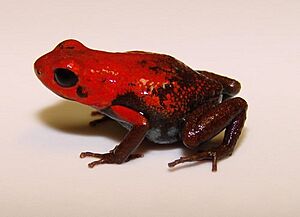Santander poison frog facts for kids
Quick facts for kids Santander poison frog |
|
|---|---|
 |
|
| Conservation status | |
| Scientific classification | |
| Synonyms | |
|
Minyobates virolinensis Ruiz-Carranza and Ramírez-Pinilla, 1992 |
Andinobates virolinensis (the Santander poison frog) is a species of frog in the family Dendrobatidae. It is endemic to Colombia where it is confined to the Santander and Cundinamarca departments on the Cordillera Oriental.
Description
Andinobates virolinensis are small frogs, measuring up to 19 mm (0.75 in) in snout–vent length.
Habitat, life cycle, and diet
Andinobates virolinensis live on the floor of cloud forest. Females lay the eggs in leaf-litter, and the males bring the larvae to the bromeliads. Reproduction occurs throughout the year. The diet consists of various arthropods, including mites, springtails, ants, and insect larvae. Thus, their diet is broadly similar to other poison dart frogs.
Conservation
Andinobates virolinensis is considered "Vulnerable" by the IUCN because it is found in very few locations and because its habitat is threatened by habitat loss, primarily due to agricultural expansion. However, it is a common species in the zones it does inhabit.
Andinobates virolinensis is sometimes traded and sold as a pet, despite INDERENA Decree # 39 (July 1985) that forbade the collection of dendrobatids from the wild for breeding (or other) purposes.


